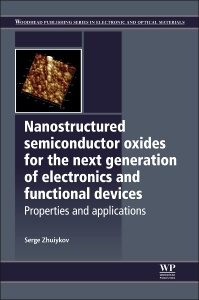Nanostructured Semiconductor Oxides for the Next Generation of Electronics and Functional Devices Properties and Applications Woodhead Publishing Series in Electronic and Optical Materials Series
Auteur : Zhuiykov Serge

Nanostructured Semiconductor Oxides for the Next Generation of Electronics and Functional Devices focuses on the development of semiconductor nanocrystals, their technologies and applications, including energy harvesting, solar cells, solid oxide fuel cells, and chemical sensors. Semiconductor oxides are used in electronics, optics, catalysts, sensors, and other functional devices. In their 2D form, the reduction in size confers exceptional properties, useful for creating faster electronics and more efficient catalysts.
After explaining the physics affecting the conductivity and electron arrangement of nanostructured semiconductors, the book addresses the structural and chemical modification of semiconductor nanocrystals during material growth. It then covers their use in nanoscale functional devices, particularly in electronic devices and carbon nanotubes. It explores the impact of 2D nanocrystals, such as graphene, chalcogenides, and oxide nanostructures, on research and technology, leading to a discussion of incorporating graphene and semiconductor nanostructures into composites for use in energy storage. The final three chapters focus on the applications of these functional materials in photovoltaic cells, solid oxide fuel cells, and in environmental sensors including pH, dissolved oxygen, dissolved organic carbon, and dissolved metal ion sensors.
Nanostructured Semiconductor Oxides for the Next Generation of Electronics and Functional Devices is a crucial resource for scientists, applied researchers, and production engineers working in the fabrication, design, testing, characterization, and analysis of new semiconductor materials. This book is a valuable reference for those working in the analysis and characterization of new nanomaterials, and for those who develop technologies for practical devices fabrication.
- About the author
- Woodhead Publishing Series in Electronic and Optical Materials
- Introduction
- Acknowledgements
- Dedication
- 1: Electrons and holes in a semiconductor
- Abstract
- 1.1 Order and disorder in semiconductor crystals
- 1.2 Electrical conductivity of semiconductor crystals
- 1.3 Mechanisms of n- and p-type conductivity
- 1.4 The energy spectrum of an electron in an infinite crystal lattice
- 1.5 The energy spectrum of an electron in a finite crystal lattice
- 1.6 Statistics of electrons and holes in semiconductors
- 1.7 Limits of the band theory of semiconductors
- 1.8 State-of-the-art techniques for characterization of nanostructured semiconductors
- 2: Structural and chemical modification of semiconductor nanocrystals
- Abstract
- 2.1 Introduction
- 2.2 Vapour-phase material growth
- 2.3 Solution-phase material growth
- 2.4 Vertical and horizontal alignment strategies
- 2.5 Doping of metal oxide semiconductor systems
- 2.6 Energy harvesting based on semiconductor piezoelectric nanostructures
- 2.7 Physical electrochemistry of semiconductor nanocrystals
- 2.8 Structural and electrochemical properties of semiconductor nanocrystals
- 3: Electronic devices and functional structures based on nanostructured semiconductors
- Abstract
- 3.1 Introduction to novel nanoscale devices from nanostructured semiconductors
- 3.2 Tunable electronic devices
- 3.3 Optoelectronics based on nanostructured semiconductors
- 3.4 Resonators and cantilevers based on nanostructured semiconductors
- 3.5 Functional structures: carbon nanotubes
- 3.6 Carbon nanotubes for environmental sensors
- 4: Two-dimensional semiconductor nanocrystals: new direction in science and technology
- Abstract
- 4.1 Physical and chemical properties of graphene
- 4.2 The impact of these properties on science and industry
- 4.3 Chalcogenide semiconductor nano-crystals
- 4.4 Titanium dioxide nanocrystals
- 4.5 Molybdenum trioxide nanocrystals
- 4.6 Tungsten trioxide nanocrystals
- 4.7 Niobium pentoxide nanocrystals
- 4.8 Tantalum pentoxide nanocrystals
- 4.9 Zinc oxide nanocrystals
- 4.10 Impact of combining two-dimensional semiconductor nanocrystals into three-dimensional structure
- 5: Composite graphene/semiconductor nanostructures for energy storage
- Abstract
- 5.1 Performance of graphene in lithium ion batteries
- 5.2 Performance of graphene in electrochemical capacitors
- 5.3 Prospects of using graphene in lithium ion batteries (LIBs) and electrochemical capacitors (ECs)
- 5.4 Composite graphene/semiconductor nanocrystals in LIBs and ECs
- 5.5 Development of three-dimensional conductive networks
- 5.6 Nanostructured thermopower wave sources
- 6: Nanostructured semiconductor composites for solar cells
- Abstract
- 6.1 Operating principle of a liquid-junction photovoltaic cell
- 6.2 Nanostructured semiconductors as solar harvesting materials: strategic potential of inorganic semiconductors in photovoltaics
- 6.3 Principles of inorganic solid-state nanostructured solar cells
- 6.4 Structured transparent electron conductors
- 6.5 Semiconductor quantum dot absorbers
- 6.6 Dye-sensitized solar cells (DSSCs)
- 6.7 Future trends in technological development
- 7: Nanostructured semiconductor composites for solid oxide fuel cells (SOFCs)
- Abstract
- 7.1 Introduction to materials and designs for solid oxide fuel cells (SOFCs)
- 7.2 Nanostructured cathode materials
- 7.3 Electrolytes for SOFCs
- 7.4 Nanostructured anode materials
- 7.5 Interconnects for SOFCs
- 7.6 Miniaturisation of SOFCs
- 7.7 Low-temperature SOFCs
- 7.8 Toward further performance increase of SOFCs at lower temperatures
- 7.9 Rational SOFC material design: new advances and tools
- 7.10 SOFC applications and markets
- 8: Semiconductor nanocrystals in environmental sensors
- Abstract
- 8.1 Solid-state pH sensors
- 8.2 Electrochemical dissolved oxygen (DO) sensors
- 8.3 Conductivity measurements
- 8.4 Antifouling technologies for solid-state water quality sensors
- 8.5 Solid-state turbidity sensors
- 8.6 Solid-state dissolved organic carbon (DOC) sensors
- 8.7 Solid-state dissolved metal ion sensors
- 8.8 Future trends
- Index
- Focuses on the development of semiconductor nanocrystals, their technologies and applications, including energy harvesting, solar cells, solid oxide fuel cells, and chemical sensors
- Reviews fundamental physics of conductivity and electron arrangement before proceeding to practical applications
- A vital resource for applied researchers and production engineers working with new semiconductor materials
Date de parution : 10-2018
Ouvrage de 466 p.
15.5x23.2 cm
Ancienne édition
Accéder à la nouvelle édition.
Date de parution : 12-2013
Ouvrage de 466 p.
15.5x23.2 cm
Ancienne édition
Accéder à la nouvelle édition.



